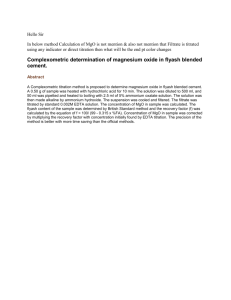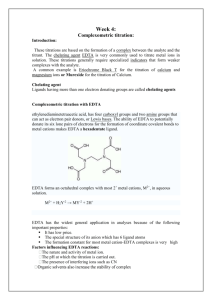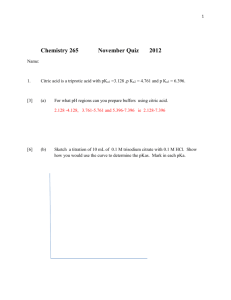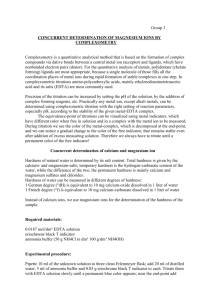Complexometric Titrations
advertisement
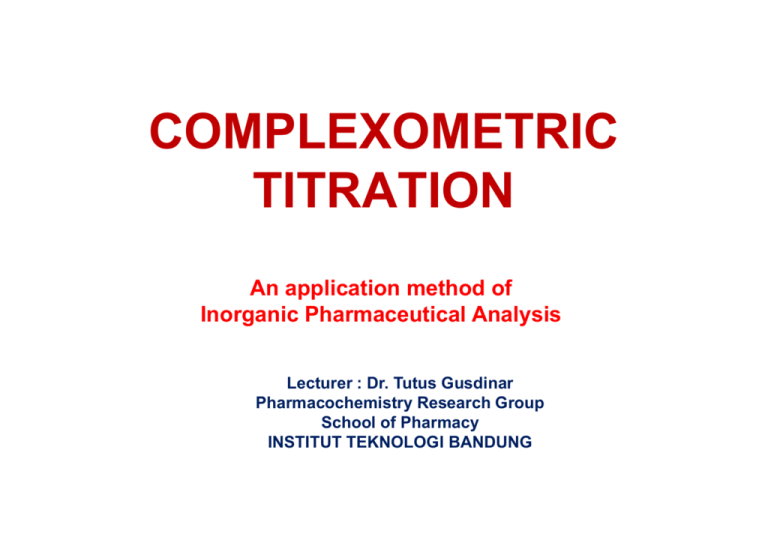
COMPLEXOMETRIC TITRATION An application method of Inorganic Pharmaceutical Analysis Lecturer : Dr. Tutus Gusdinar Pharmacochemistry Research Group School of Pharmacy INSTITUT TEKNOLOGI BANDUNG • Complexometric titration is a type of titration based on complex formation between the analyte and titrant. • Complexometric titrations are particularly useful f l ffor determination d t i ti off a mixture i t off different metal ions in solution. An indicator with a marked color change is usually used to detect the end-point end point of the titration. Any complexation reaction can in theory be applied as a volumetric technique provided that : • the reaction reaches equilibrium rapidly following each addition of titrant. • interfering situations do not arise (such as stepwise formation of various complexes resulting in the presence of more than one complex in solution in significant concentration during the titration process). process) • an complexometric indicator capable of locating equivalence point with fair accuracy is available I practice, In ti the th use off EDTA as a tit titrantt iis well ll established. t bli h d Complexometric titration with EDTA Ethylenediamminetetraacetic acid, has four carboxyl groups and two amine groups that can act as electron pair donors donors, or Lewis bases. The ability of EDTA to potentially donate its six lone pairs of electrons for the formation of coordinate covalent bonds to metal cations makes EDTA a hexadentate ligand. However in practice EDTA is usually only partially ionized However, ionized, and thus forms fewer than six coordinate covalent bonds with metal cations Disodium EDTA cations. EDTA, commonly used in the standardization of aqueous solutions of transition metal cations, only forms four coordinate covalent bonds to metal cations at pH values less than or equal to 12 as in this range of pH values the amine groups remain protonated and thus unable to donate electrons to the formation of coordinate covalent bonds. In analytical chemistry the shorthand "Na2H2Y" is typically used to designate disodium EDTA. This shorthand can be used to designate any species of EDTA. The "Y" stands for the EDTA molecule, and the "Hn" designates the number of acidic protons bonded to the EDTA molecule. EDTA forms an octahedral complex with most 2+ metal cations M2+, in aqueous solution cations, solution. The main reason that EDTA is used so extensively in the standardization of metal cation solutions is that the formation constant for most metal cationEDTA complexes is very high, meaning that the equilibrium for the reaction : 2 + H Y → MH Y + 2H+ M2+ 4 2 lies far to the right. Carrying out the reaction in a basic buffer solution removes H+ as it is formed formed, which also drives the reaction to the right. For most purposes it can be considered that the formation of the metal cation-EDTA complex p g goes to completion, and this is chiefly why EDTA is used in titrations / standardizations of this type. To carry outt metal T t l cation ti titrations tit ti using i EDTA it is i almost l t always necessary to use a complexometric indicator, usually an organic dye such as Fast Sulphon Black, Black Eriochrome Black T, Eriochrome Red B or Murexide, to determine when the end point has been reached. These dyes bind to the metal cations in solution to form colored complexes. comple es However, Ho e er since EDTA binds to metal cations much more strongly than does the dye used as an indicator the EDTA will displace the dye from the metal cations as it is added to the solution of analyte. A color change in the solution being titrated indicates that all of the dye has been displaced from the metal cations in solution and that the endpoint has been reached solution, reached. Molecular structure of EDTA • Complexometric p titration has made it possible for man to be exposed to an advanced method of titration which not only enables us to analyze more ions, but also do them in very small quantities quantities. • We’ve to be aware of the effects of p pH on the titration method. Complex ion titration is possible in very minute quantities quantities. The biological use of complexometric titration seems to involve an advanced method of this kind of titration; and we can learn its application li ti on liliving i cells. ll The general shape of titration curves obtained by titrating 10.0 mL of a 0 01 solution off a metal ion M with a 0 0.01M 0.01 01 M EDTA solution. The apparent stability constants of various metal-EDTA complexes are indicated at the extreme right of the curves curves. It is evident that the greater the stability constant, the sharper is the end point provided the pH is maintained constant. In acid-base titrations the end point is generally detected by a pH-sensitive i di t IIn th indicator. the EDTA tit titration ti a metal t l ion i sensitive iti indicator i di t ( metal t l indicator or metal-ion indicator) is often employed to detect changes of pM. Such indicators (which contain types of chelate groupings and generally possess resonance systems typical of dyestuffs) form complexes with specific metal ions, which differ in colour from the free indicator and produce a sudden colour change at the equivalence point. The end point of the titration can also be evaluated by other methods including potentiometric, amperometric, t i and d spectrophotometric t h t t i techniques. t h i A. Direct titration. The solution containing the metal ion to be determined is buffered to the desired p pH ((e.g. g to p pH = 10 with NH:-aq. q NH,) ,) and titrated directly with the standard EDTA solution. It may be necessary to prevent precipitation of the hydroxide of the metal (or a basic salt) by the addition of some auxiliary complexing agent agent, such as tartrate or citrate or triethanolamine. At the equivalence point the magnitude of the concentration of the metal ion being determined decreases abruptly abruptly. This is generally determined by the change in colour of a metal indicator or by amperometric, spectrophotometric, or potentiometric methods. B. Back-titration. Many metals cannot, for various reasons, be titrated directly; thus they may precipitate from the solution in the pH range necessary for the titration, or they may form inert complexes, or a suitable metal indicator is not available. In such cases an excess of standard EDTA solution is added, the resulting g solution is buffered to the desired pH, and the excess of the EDTA is back-titrated with a standard metal ion solution; a solution of zinc chloride or sulphate or of magnesium chloride or sulphate is often used for this purpose. The end point is detected with the aid of the metal indicator which responds to the zinc or magnesium ions introduced in the back-titration. C. Replacement or substitution titration. Substitution titrations may be used for metal ions that do not react (or react unsatisfactorily) with a metal indicator, or for metal ions which form EDTA complexes p that are more stable than those of other metals such as magnesium and calcium. The metal cation Mn+ to be determined may be treated with the magnesium complex of EDTA, when the following reaction occurs : The amount of magnesium ion set free is equivalent to the cation present and can be titrated with a standard solution of EDTA and a suitable metal indicator. An iinteresting A i application li i iis the h titration i i off calcium. l i IIn the h di direct titration i i of calcium ions, solochrome black gives a poor end point; if magnesium is present, it is displaced from its EDTA complex by calcium and an improved end point results D. Alkalimetric titration. When a solution of disodium ethylenediaminetetraacetate, Na2H2Y, is added to a solution containing metallic ions ions, complexes are formed with the liberation of two equivalents of hydrogen ion: The hydrogen ions thus set free can be titrated with a standard solution of sodium hydroxide using an acid-base indicator or a potentiometric end point;; alternatively, p y, an iodate-iodide mixture is added as well as the EDTA solution and the liberated iodine is titrated with a standard thiosulphate solution. The solution of the metal to be determined must be accurately neutralised before titration; this is often a difficult matter on account of the hydrolysis of many salts, salts and constitutes a weak feature of alkalimetric titration titration. E. Miscellaneous methods. Exchange reactions between the tetracyanonickelate( I1) ion [Ni(CN),I2- (the potassium salt is readily prepared) and the element to be determined whereby nickel ions are set free determined, free, have a limited application application. Thus silver and gold, which themselves cannot be titrated complexometrically, can be determined in this way. These reactions take place with sparingly soluble silver salts, and hence provide a method for the determination of the halide ions Cl-, Br-, 1-, and the thiocyanate ion SCN-. The anion is first precipitated as the silver salt, the latter dissolved in a solution of [[Ni(CN),I2-, ( ), , and the equivalent q amount of nickel therebyy set free is determined by rapid titration with EDTA using an appropriate indicator (murexide, bromopyrogallol red). Fluoride may be determined by precipitation as lead chlorofluoride, the precipitate being dissolved in dilute nitric acid and, after adjusting the pH to 5-6, the lead is titrated with EDTA using xylenol orange indicator. Sulphate may be determined by precipitation as barium sulphate or as lead sulphate. sulphate The precipitate is dissolved in an excess of standard EDTA solution, and the excess of EDTA is back-titrated with a standard magnesium or zinc solution using solochrome black as indicator. Phosphate may be determined by precipitating as Mg(NH,) PO,, 6H2 O, dissolving the precipitate in dilute hydrochloric acid, adding an excess of standard EDTA solution, buffering at pH = 10, and back-titrating with standard magnesium ion solution in the presence of solochrome black. TlTRATlON OF MIXTURES,, SELECTIVITY, MASKING AND DEMASKING AGENTS EDTA is a very unselective reagent because it complexes with numerous doubly, triply and quadruply charged cations. When a solution containing two cations which complex with EDTA is titrated without the addition of a complex-forming l f i iindicator, di t and d if a tit titration ti error off 0 0.1 1 per centt iis permissible, then the ratio of the stability constants of the EDTA complexes of the two metals M and N must be such that KM/KN > 106 if N is not to interfere with the titration of M. Strictly, of course, the constants KM and KN considered in the above expression should be the apparent stability constants of the complexes. If complex-forming indicators are used, then for a similar titration error KM/KN > 108. The following procedures will help to increase the selectivity : (a) Suitable control of the pH of the solution. This, of course, makes use of the different stabilities of metal-EDTA complexes. Thus bismuth and thorium can be titrated in an acidic solution (pH = 2) with xylenol orange or methylthymol blue as indicator and most divalent cations do not interfere. A mixture of bismuth and lead ions can be successfully titrated by first titrating the bismuth at pH 2 with xylenol orange as indicator, and then adding hexamine to raise the pH to about 5, and titrating the lead. ( ) Use of masking (b) g agents. g Masking may be defined as the process in which a substance, without physical separation of it or its reaction products, is so transformed that it does not enter into a particular reaction. Demasking is the process in which the masked substance regains its ability to enter into a particular reaction. reaction By the use of masking agents, some of the cations in a mixture can often be 'masked' so that they y can no longer g react with EDTA or with the indicator. An effective masking agent is thecyanide ion; this forms stable cyanide complexes with the cations of Cd, Zn, Hg(II), Cu, Co, Ni, Ag, and the platinum metals, but not with the alkaline earths, manganese, and lead : It is therefore possible to determine cations such as Ca2+, Mg2+, Pb2+, and Mn2+ in the presence of the above-mentioned metals by masking with an excess of p potassium or sodium cyanide. y A small amount of iron may be masked by cyanide if it is first reduced to the iron(II) state by the addition of ascorbic acid. Titanium(IV), iron(III), and aluminium can be masked with triethanolamine; mercury with iodide ions; and aluminium, iron(III), titanium(IV), and tin(II) with ammonium fluoride (the cations of the alkaline-earth alkaline earth metals yield slightly soluble fluorides) fluorides). y be transformed into a different oxidation state: Sometimes the metal may thus copper(II) may be reduced in acid solution by hydroxylamine or ascorbic acid. After rendering ammoniacal, nickel or cobalt can be titrated using, for example, murexide as indicator without interference from the copper, which is now present as Cu(I). Iron(III) can often be similarly masked by reduction with ascorbic acid. acid ( ) Selective demasking. (c) g The cyanide complexes of zinc and cadmium may be demasked with formaldehyde-acetic acid solution or, better, with chloral hydrate : The use of masking and selective demasking agents permits the successive titration of many metals. Thus a solution containing Mg, Zn, and Cu can be titrated as follows: 1 Add excess off standard 1. t d d EDTA and db back-titrate k tit t with ith standard t d d Mg M solution using solochrome black as indicator. This gives the sum of al1 the metals present. 2. Treat an aliquot portion with excess of KCN (Poison !) and titrate as before. This gives Mg only. 3. Add excess of chloral hydrate y (or ( of formaldehyde-acetic y acid solution, 3:1) to the titrated solution in order to liberate the Zn from the cyanide complex, and titrate until the indicator turns blue. This gives the Zn only. The Cu content may then be found by difference. (d) Classical separation. These may be applied if they are not tedious; thus the following precipitates may be used for separations in which which, after being re-dissolved, the cations can be determined complexometrically : CaC2O4, nickel dimethylglyoximate, Mg(NH2)P04,6H2O, and CuSCN. (e) Solvent extraction. extraction This is occasionally of value value. Thus zinc can be separated from copper and lead by adding excess of ammonium thiocyanate solution and extracting the resulting zinc thiocyanate with 4-methylpentan-2-one (isobutyl methyl ketone); the extract is diluted with water and the zinc content determined with EDTA solution. (f) Choice of indicators. The indicator chosen should be one for which the formation of the metal-indicator complex p is sufficiently y rapid p to p permit establishment of the end point without undue waiting, and should preferably be reversible. (g) Removal of anions. Anions, such as orthophosphate, which can interfere in complexometric titrations may be removed using ion exchange resins. For the use of ion exchange resins in the separation of cations and their subsequent EDTA titration. (h) 'Kinetic masking'. This is a special case in which a metal ion does not effectively enter into the complexation reaction because of its kinetic inertness. Thus the slow reaction of chromium(III) with EDTA makes it possible to titrate other metal t l ions i which hi h reactt rapidly, idl without ith t iinterference t f ffrom C Cr(III); (III) this thi is i illustrated ill t t d b by the determination of iron(III) and chromium(III) in a mixture. Dyestuffs which form complexes with specific metal pM values;; 1:1cations can serve as indicators of p complexes (metal : dyestuff = 1:1) are common, but 1:2-complexes and 2:1-complexes also occur. The metal ion indicators, like EDTA itself, are chelating agents; this implies that the dyestuff molecule possesses several ligand atoms suitably disposed for coordination with a metal atom. They can, of course, equally take up protons, which also produces d a colour l change; h metal t l iion iindicators di t are therefore not only pM but also pH indicators. METAL ION INDICATORS The success of an EDTA titration depends upon the precise determination of the end point. The most common procedure utilises metal ion indicators. The requisites of a metal ion indicator for use in the visual detection of end points include : (a) The colour reaction must be before the end point, when nearly all the metal ion is complexed with EDTA EDTA, the solution is strongly coloured coloured. (b) The colour reaction should be specific or selective. (c) The metal-indicator complex must possess sufficient stability, otherwise, due to di dissociation, i ti a sharp h colour l change h iis nott attained. tt i d Th The metal-indicator t l i di t complex l must, however, be less stable than the metal-EDTA complex to ensure that, at the end point, EDTA removes metal ions from the metal indicator-complex. The change in equilibrium from the metal indicator complex to the metal metal-EDTA EDTA complex should be sharp and rapid. (d) The colour contrast between the free indicator and the metal-indicator complex should be readily observed observed. (e) The indicator must be very sensitive to metal ions (i.e. to pM) so that the colour change occurs as near to equivalence point as possible. (f) The above requirements must be fulfilled within the pH range at which the titration is performed. Theory of the visual use of metal t l ion i indicators i di t Discussion will be confined to the more common 1:1-complexes. The use of a metal ion indicator in an EDTA titration may be written as: This reaction will proceed iff the metal-indicator complex M-In is less stable than the metal-EDTA complex M-EDTA. The former dissociates to a limited extent, and during the titration the free metal ions are progressively complexed by the EDTA until ultimately lti t l the th metal t l is i displaced di l d ffrom th the complex l M M-In I to t leave l the th free f indicator i di t (In). The stability of the metal-indicator complex may be expressed in terms of the formation constant (or indicator constant) KIn: The indicator colour change is affected by the hydrogen ion concentration of the solution, solution and no account of this has been taken in the above expression for the formation constant. Thus solochrome black, which may be written as H2In-, exhibits the following acid-base behaviour : Practical considerations 1) Adjustment of pH. For many EDTA titrations F tit ti the th pH H off the th solution l ti is i extremely t l critical; iti l often limits of 11 unit of pH, and frequently limits of 10.5 unit of pH must be achieved for a successful titration to be carried out out. To achieve such narrow limits of control it is necessary to make use of a pH meter while adjusting the pH value of the solution, and even for those cases where the latitude is such that a pH test-paper can be used to control the adjustment of pH, only a paper of the narrow range variety should b used. be d 2) Concentration of the metal ion to be titrated. Most titrations are successful with 0.25 millimole of the metal ion concerned in a volume of 50 50-150mL 150mL of solution. solution If the metal ion concentration is too high, then the end point may be very difficult to discern, and if difficulty y is experienced p with an end p point then it is advisable to start with a smaller portion of the test solution, and to dilute this to 100-150 mL before adding the buffering medium and the indicator, and then repeating the titration. 3) Amount of indicator. The addition of too much indicator is a fault which must be guarded against: in many cases the colour due to the indicator intensifies considerably y during g the course of the titration,, and further,, manyy Indicators exhibit dichroism, i.e. there is an intermediate colour change one to two drops before the real end-point. Thus, for example, in the titration of lead using xylenol orange as indicator at pH = 6, 6 the initial reddish-purple colour becomes orange-red, and then with the addition of one or two further drops of reagent, the solution acquires the final lemon yellow colour colour. This end point anticipation, anticipation which is of great practical value, may be virtually lost if too much of the indicator is added so that the colour is too intense. In general, a satisfactory colour is achieved by th use off 30-50 the 30 50 mg off a 1 per centt solid lid mixture i t off th the iindicator di t in i potassium nitrate. 4) Attainment of the end point. In many EDTA titrations the colour change in the neighbourhood of the end p point may y be slow. In such cases,, cautious addition of the titrant coupled with continuous stirring of the solution is advisable; the use of a magnetic stirrer is recommended. Frequently, a sharper end point may be achieved if the solution is warmed to about 40 OC. Titrations with CDTA are always slower in the region of the end point than the corresponding EDTA titrations. 5) Detection D t ti off th the colour l change. h With all of the metal ion indicators used in complexometric p titrations,, detection of the end point of the titration is dependent upon the recognition of a specified change in colour; for many observers this can be a difficult task task, and for those affected by colour blindness it may be virtually impossible. These difficulties may be overcome by replacing the eye by a photocell which is much more sensitive, and eliminates the human element element. To carry out the requisite operations it is necessary to have available a colorimeter l i t or a spectrometer t t in i which hi h th the cellll compartment t t is i large enough to accommodate the titration vessel (a conical flask or a tall form beaker). A simple apparatus may be readily constructed in which light passing through the solution is first allowed to strike a suitable filter and then a photocell; the current generated in the latter g is measured with a galvanometer. 6) Alternative methods of detecting the end point. point In addition to the visual and spectrophotometric detection of end points i t iin EDTA titrations tit ti with ith th the aid id off metal t l iion iindicators, di t th the following methods are also available for end point detection : • Potentiometric titration using a mercury electrode. • Potentiometric titration using a selective ion electrode responsive to the ion being g titrated. • Potentiometric titration using a bright platinum-saturated calomel electrode system; this can be used when the reaction involves two different oxidation states of a given metal metal. • By amperometric titration. • By coulometric analysis. • By conductimetric titration. titration Some applications in human life Complexometric and Medicine Complexometric is widely used in the medical industry because of the microliter-size microliter size sample involved. The method is efficient in research related to the biological cell. • Ability to titrate the amount of ions available in a living cell. • Ability to introduce ions into a cell in case of deficiencies. Complexometric tiration involves the treatment of complex ions such as magnesium, calcium, copper, iron, nickel, lead and zinc with EDTA as the complexing agent. The titration of EDTA depends on pH stability. Performed at high (basic) pH, i.e. pH 10 for Ca+2 or Mg+2 High Formation Constant Constant, Kf Diffusional Microburette : used to deliver the EDTA in microscopic droplets, as low as 6 fmol/s, observed under p microscope. Complexometric p Titration and Water Hardness Complexometric titration is an efficient method for g the level of hardness of water. Caused by y determining accumulation of mineral ions, pH of water is increased. The Kf during the titration of hard water is reduced because of the reduced amount of EDTA added. Softening of hard water is done by altering the pH of the water reducing the concentration of the metal ions present present. Could be performed in two phases : Basic pH for ions with g Kf e.g. g Ca+2 and Mg g+2 high Zinc in Water The traces of zinc in water can be determined with complexometric titration titration. Results from these analysis show that 5 bottles of water daily for minimum zinc q quantity. y The amount of Zn in soil water has been increased by bio-activities bio activities. The EDTA could also be performed for complex metal ions at lower pH. pH Zinc has a low Kf = 3.16 x 10-17 Zn+2 can be titrated in acidic pH 5 5.5 5 Zinc in Food Certain foods contain zinc in small amounts. Oysters and other seafood, meat, liver, eggs, milk and brewer's yeast. Zinc deficiency is rare rare. It occurs when there is : • Excess alcohol • Excess exercisec as sweat depletes zinc stores • A strict vegetarian diet Zinc in the Body • Reduces zinc-containing enzyme, carbonic anhydrase in red blood cells. • Guard against infections • Repair wounds • Brain development • Smell sensation • Beef contains the most amount of vitamins • Vegetarians V t i iin US gett 10-30% less zinc than non-vegetarians non vegetarians. • The average adult man is gets ge s abou about 90% o of the e recommended level of zinc; women, 25%. Kids are also below the recommended level. The END

